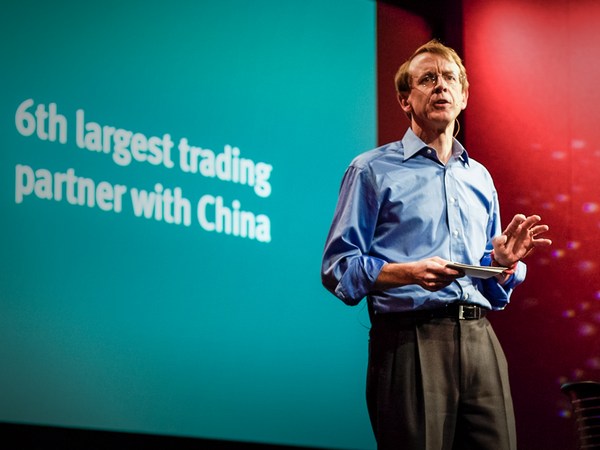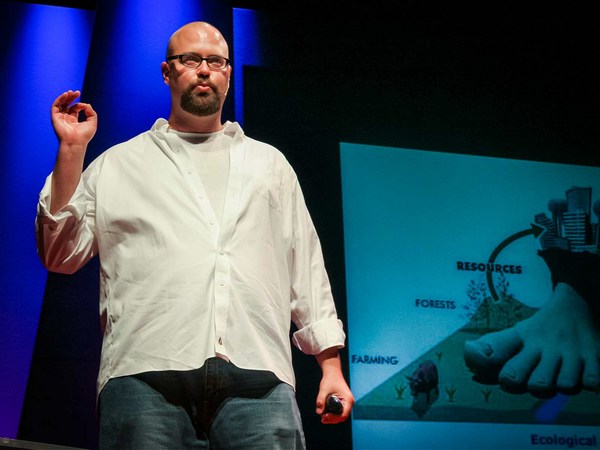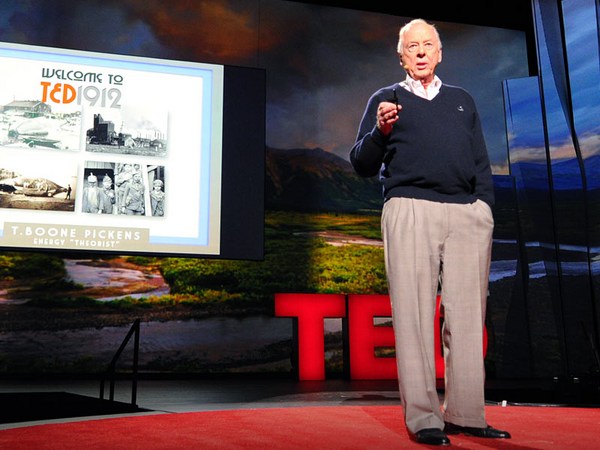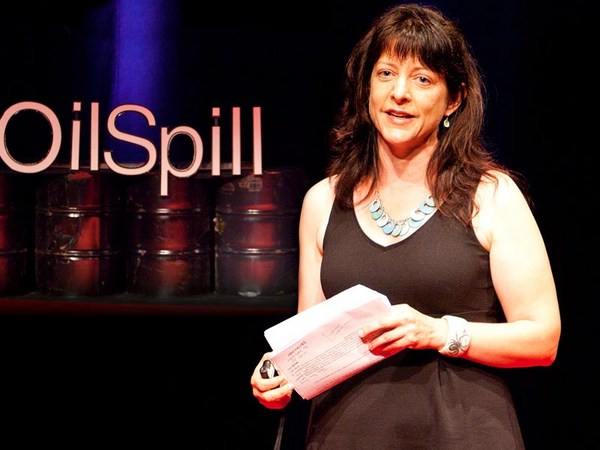What is bioenergy? Bioenergy is not ethanol. Bioenergy isn't global warming. Bioenergy is something which seems counterintuitive. Bioenergy is oil. It's gas. It's coal. And part of building that bridge to the future, to the point where we can actually see the oceans in a rational way, or put up these geo-spatial orbits that will twirl or do microwaves or stuff, is going to depend on how we understand bioenergy and manage it. And to do that, you really have to look first at agriculture.
So we've been planting stuff for 11,000 years. And in the measure that we plant stuff, what we learn from agriculture is you've got to deal with pests, you've got to deal with all types of awful things, you've got to cultivate stuff. In the measure that you learn how to use water to cultivate, then you're going to be able to spread beyond the Nile. You're going to be able to power stuff, so irrigation makes a difference.
Irrigation starts to make you be allowed to plant stuff where you want it, as opposed to where the rivers flood. You start getting this organic agriculture; you start putting machinery onto this stuff. Machinery, with a whole bunch of water, leads to very large-scale agriculture. You put together machines and water, and you get landscapes that look like this. And then you get sales that look like this. It's brute force. So what you've been doing in agriculture is you start out with something that's a reasonably natural system. You start taming that natural system. You put a lot of force behind that natural system. You put a whole bunch of pesticides and herbicides -- (Laughter) -- behind that natural system, and you end up with systems that look like this.
And it's all brute force. And that's the way we've been approaching energy. So the lesson in agriculture is that you can actually change the system that's based on brute force as you start merging that system and learning that system and actually applying biology. And you move from a discipline of engineering, you move from a discipline of chemistry, into a discipline of biology. And probably one of the most important human beings on the planet is this guy behind me.
This is a guy called Norman Borlaug. He won the Nobel Prize. He's got the Congressional Medal of Honor. He deserves all of this stuff. And he deserves this stuff because he probably has fed more people than any other human being alive because he researched how to put biology behind seeds. He did this in Mexico. The reason why India and China no longer have these massive famines is because Norman Borlaug taught them how to grow grains in a more efficient way and launched the Green Revolution. That is something that a lot of people have criticized. But of course, those are people who don't realize that China and India, instead of having huge amounts of starving people, are exporting grains.
And the irony of this particular system is the place where he did the research, which was Mexico, didn't adopt this technology, ignored this technology, talked about why this technology should be thought about, but not really applied. And Mexico remains one of the largest grain importers on the planet because it doesn't apply technology that was discovered in Mexico. And in fact, hasn't recognized this man, to the point where there aren't statues of this man all over Mexico. There are in China and India. And the Institute that this guy ran has now moved to India. That is the difference between adopting technologies and discussing technologies. Now, it's not just that this guy fed a huge amount of people in the world. It's that this is the net effect in terms of what technology does, if you understand biology.
What happened in agriculture? Well, if you take agriculture over a century, agriculture in about 1900 would have been recognizable to somebody planting a thousand years earlier. Yeah, the plows look different. The machines were tractors or stuff instead of mules, but the farmer would have understood: this is what the guy's doing, this is why he's doing it, this is where he's going. What really started to change in agriculture is when you started moving from this brute force engineering and chemistry into biology, and that's where you get your productivity increases. And as you do that stuff, here's what happens to productivity.
Basically, you go from 250 hours to produce 100 bushels, to 40, to 15, to five. Agricultural labor productivity increased seven times, 1950 to 2000, whereas the rest of the economy increased about 2.5 times. This is an absolutely massive increase in how much is produced per person. The effect of this, of course, is it's not just amber waves of grain, it is mountains of stuff. And 50 percent of the EU budget is going to subsidize agriculture from mountains of stuff that people have overproduced.
This would be a good outcome for energy. And of course, by now, you're probably saying to yourself, "Self, I thought I came to a talk about energy and here's this guy talking about biology." So where's the link between these two things? One of the ironies of this whole system is we're discussing what to do about a system that we don't understand. We don't even know what oil is. We don't know where oil comes from. I mean, literally, it's still a source of debate what this black river of stuff is and where it comes from. The best assumption, and one of the best guesses in this stuff, is that this stuff comes out of this stuff, that these things absorb sunlight, rot under pressure for millions of years, and you get these black rivers.
Now, the interesting thing about that thesis -- if that thesis turns out to be true -- is that oil, and all hydrocarbons, turned out to be concentrated sunlight. And if you think of bioenergy, bioenergy isn't ethanol. Bioenergy is taking the sun, concentrating it in amoebas, concentrating it in plants, and maybe that's why you get these rainbows. And as you're looking at this system, if hydrocarbons are concentrated sunlight, then bioenergy works in a different way. And we've got to start thinking of oil and other hydrocarbons as part of these solar panels. Maybe that's one of the reasons why if you fly over west Texas, the types of wells that you're beginning to see don't look unlike those pictures of Kansas and those irrigated plots.
This is how you farm oil. And as you think of farming oil and how oil has evolved, we started with this brute force approach. And then what did we learn? Then we learned we had to go bigger. And then what'd we learn? Then we have to go even bigger. And we are getting really destructive as we're going out and farming this bioenergy. These are the Athabasca tar sands, and there's an enormous amount -- first of mining, the largest trucks in the world are working here, and then you've got to pull out this black sludge, which is basically oil that doesn't flow. It's tied to the sand. And then you've got to use a lot of steam to separate it, which only works at today's oil prices.
Coal. Coal turns out to be virtually the same stuff. It is probably plants, except that these have been burned and crushed under pressure. So you take something like this, you burn it, you put it under pressure, and likely as not, you get this. Although, again, I stress: we don't know. Which is curious as we debate all this stuff. But as you think of coal, this is what burned wheat kernels look like. Not entirely unlike coal.
And of course, coalmines are very dangerous places because in some of these coalmines, you get gas. When that gas blows up, people die. So you're producing a biogas out of coal in some mines, but not in others. Any place you see a differential, there're some interesting questions. There's some questions as to what you should be doing with this stuff. But again, coal. Maybe the same stuff, maybe the same system, maybe bioenergy, and you're applying exactly the same technology.
Here's your brute force approach. Once you get through your brute force approach, then you just rip off whole mountaintops. And you end up with the single largest source of carbon emissions, which are coal-fired gas plants. That is probably not the best use of bioenergy. As you think of what are the alternatives to this system -- it's important to find alternatives because it turns out that the U.S. is dwindling in its petroleum reserves, but it is not dwindling in its coal reserves, nor is China. There are huge coal reserves that are sitting out there, and we've got to start thinking of them as biological energy, because if we keep treating them as chemical energy, or engineering energy, we're going to be in deep doo-doo.
Gas is a similar issue. Gas is also a biological product. And as you think of gas, well, you're familiar with gas. And here's a different way of mining coal. This is called coal bed methane. Why is this picture interesting? Because if coal turns out to be concentrated plant life, the reason why you may get a differential in gas output between one mine and another -- the reason why one mine may blow up and another one may not blow up -- may be because there's stuff eating that stuff and producing gas. This is a well-known phenomenon. (Laughter) You eat certain things, you produce a lot of gas. It may turn out that biological processes in coalmines have the same process. If that is true, then one of the ways of getting the energy out of coal may not be to rip whole mountaintops off, and it may not be to burn coal. It may be to have stuff process that coal in a biological fashion as you did in agriculture.
That is what bioenergy is. It is not ethanol. It is not subsidies to a few companies. It is not importing corn into Iowa because you've built so many of these ethanol plants. It is beginning to understand the transition that occurred in agriculture, from brute force into biological force. And in the measure that you can do that, you can clean some stuff, and you can clean it pretty quickly. We already have some indicators of productivity on this stuff. OK, if you put steam into coal fields or petroleum fields that have been running for decades, you can get a really substantial increase, like an eight-fold increase, in your output. This is just the beginning stages of this stuff.
And as you think of biomaterials, this guy -- who did part of the sequencing of the human genome, who just doubled the databases of genes and proteins known on earth by sailing around the world -- has been thinking about how you structure this. And there's a series of smart people thinking about this. And they've been putting together companies like Synthetic Genomics, like, a Cambria, like Codon, and what those companies are trying to do is to think of, how do you apply biological principles to avoid brute force? Think of it in the following terms. Think of it as beginning to program stuff for specific purposes. Think of the cell as a hardware. Think of the genes as a software. And in the measure that you begin to think of life as code that is interchangeable, that can become energy, that can become food, that can become fiber, that can become human beings, that can become a whole series of things, then you've got to shift your approach as to how you're going to structure and deal and think about energy in a very different way.
What are the first principles of this stuff and where are we heading? This is one of the gentle giants on the planet. He's one of the nicest human beings you've ever met. His name is Hamilton Smith. He won the Nobel for figuring out how to cut genes -- something called restriction enzymes. He was at Hopkins when he did this, and he's such a modest guy that the day he won, his mother called him and said, "I didn't realize there was another Ham Smith at Hopkins. Do you know he just won the Nobel?" (Laughter) I mean, that was Mom, but anyway, this guy is just a class act. You find him at the bench every single day, working on a pipette and building stuff. And one of the things this guy just built are these things.
What is this? This is the first transplant of naked DNA, where you take an entire DNA operating system out of one cell, insert it into a different cell, and have that cell boot up as a separate species. That's one month old. You will see stuff in the next month that will be just as important as this stuff. And as you think about this stuff and what the implications of this are, we're going to start not just converting ethanol from corn with very high subsidies. We're going to start thinking about biology entering energy. It is very expensive to process this stuff, both in economic terms and in energy terms.
This is what accumulates in the tar sands of Alberta. These are sulfur blocks. Because as you separate that petroleum from the sand, and use an enormous amount of energy inside that vapor -- steam to separate this stuff -- you also have to separate out the sulfur. The difference between light crude and heavy crude -- well, it's about 14 bucks a barrel. That's why you're building these pyramids of sulfur blocks. And by the way, the scale on these things is pretty large.
Now, if you can take part of the energy content out of doing this, you reduce the system, and you really do start applying biological principles to energy. This has to be a bridge to the point where you can get to wind, to the point where you can get to solar, to the point where you can get to nuclear -- and hopefully you won't build the next nuclear plant on a beautiful seashore next to an earthquake fault. (Laughter) Just a thought.
But in the meantime, for the next decade at least, the name of the game is hydrocarbons. And be that oil, be that gas, be that coal, this is what we're dealing with. And before I make this talk too long, here's what's happening in the current energy system. 86 percent of the energy we consume are hydrocarbons. That means 86 percent of the stuff we're consuming are probably processed plants and amoebas and the rest of the stuff. And there's a role in here for conservation. There's a role in here for alternative stuff, but we've also got to get that other portion right. How we deal with that other portion is our bridge to the future. And as we think of this bridge to the future, one of the things you should ponder is: we are leaving about two-thirds of the oil today inside those wells. So we're spending an enormous amount of money and leaving most of the energy down there. Which, of course, requires more energy to go out and get energy. The ratios become idiotic by the time you get to ethanol. It may even be a one-to-one ratio on the energy input and the energy output. That is a stupid way of managing this system.
Last point, last graph. One of the things that we've got to do is to stabilize oil prices. This is what oil prices look like, OK? This is a very bad system because what happens is your hurdle rate gets set very low. People come up with really smart ideas for solar panels, or for wind, or for something else, and then guess what? The oil price goes through the floor. That company goes out of business, and then you can bring the oil price back up.
So if I had one closing and modest suggestion, let's set a stable oil price in Europe and the United States. How do you do that? Well, let's put a tax on oil that is a non-revenue tax, and it basically says for the next 20 years, the price of oil will be -- whatever you want, 35 bucks, 40 bucks. If the OPEC price falls below that, we tax it. If the OPEC price goes above that, the tax goes away. What does that do for entrepreneurs? What does it do for companies? It tells people, if you can produce energy for less than 35 bucks a barrel, or less than 40 bucks a barrel, or less than 50 bucks a barrel -- let's debate it -- you will have a business. But let's not put people through this cycle where it doesn't pay to research because your company will go out of business as OPEC drives alternatives and keeps bioenergy from happening. Thank you.





